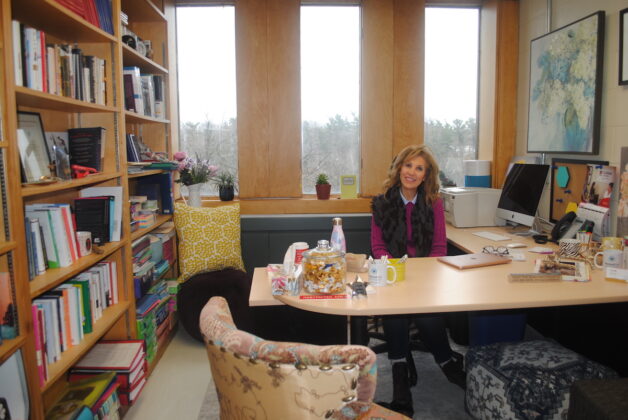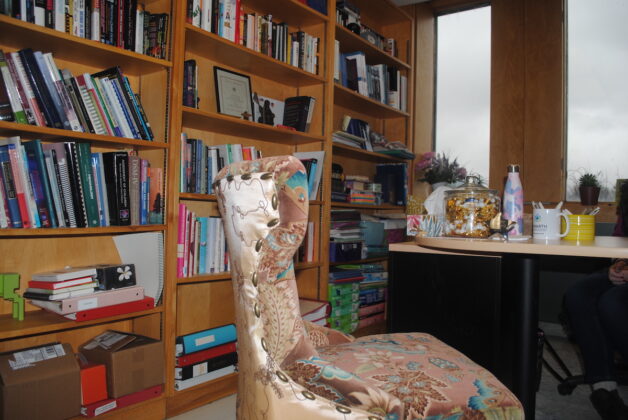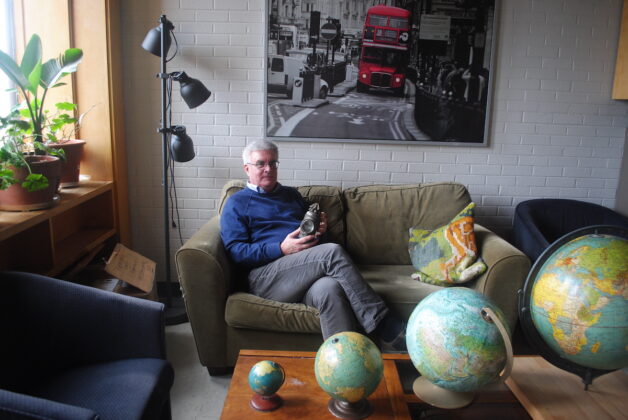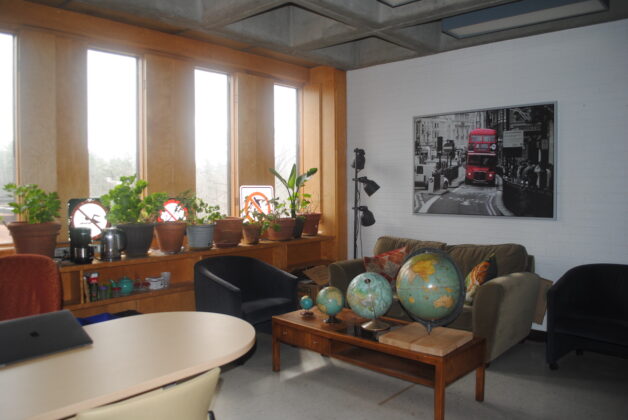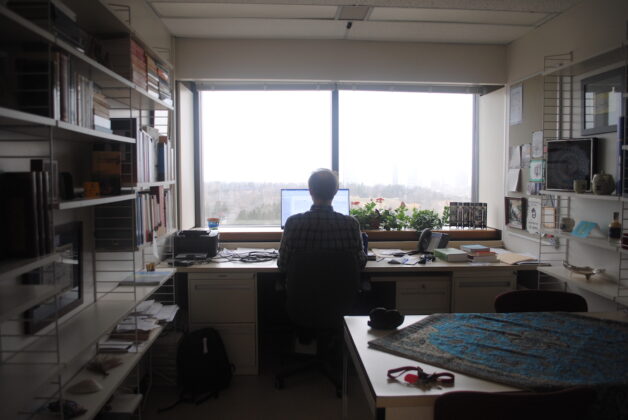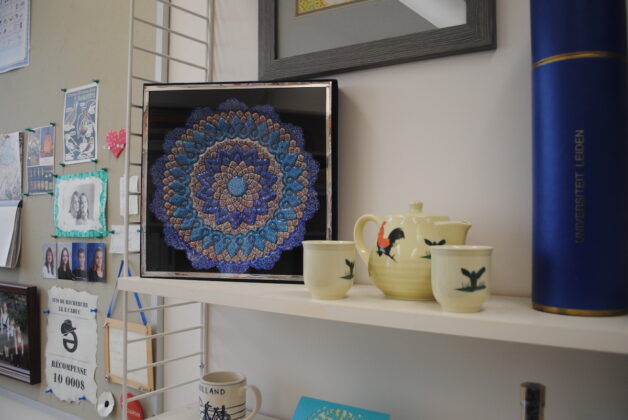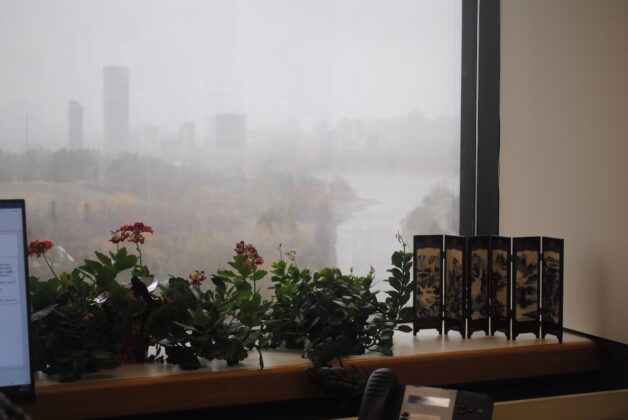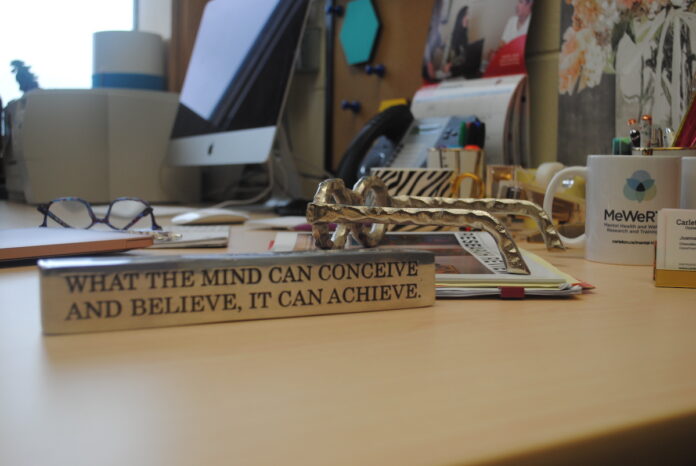
The Loeb Building, with its strange four-tower layout, is one of the more confusing structures to navigate on the Carleton University campus. However, those who do venture through the thin hallways and dead-end illusions of Loeb’s fifth floor will find the hidden gem that is Joanna Pozzulo’s office.
As a chancellor’s professor in the psychology department, Pozzulo researches sobering topics connected to the plight of vulnerable individuals in the justice system. Remarkably, much of her work is produced from an office that radiates joy.
When it comes to the stylistic choices for the space, Pozzulo said she wants to create a calm, fun environment. This ethos is apparent in the bright hues and mismatched upholstered furniture greeting guests upon entry.
Admittedly, there’s a lot to take in: A comically large red table clock, jars of candy, purple walls and at least 11 mugs filled with anything but coffee. Still, the office feels clean, organized and professional. It gives the impression that every little thing has its place.
Pozzulo told the Charlatan her favourite part of her office is the bookshelves.
“Everything on the shelves kind of has a story,” she said.
Alongside the books she’s read and written, filling the walls are little gifts from graduate students Pozzulo defended.
The space is set up with intentionality, and Pozzulo admits her ideas come from myriad sources. Beyond her love for HGTV content, she also finds inspiration in intricate set designs from movies and television series.
“I can get really obsessed with the background and forget the story of what’s going on,” she said, citing Only Murders In The Building as a recent favourite.
For anyone unfamiliar with the Hulu original series (go watch it — the cast is absolutely stacked), the story follows unique characters who share nothing in common other than the massive apartment complex they call home.
What makes the interior design of the series so great (and Emmy award-winning, I might add) is that it does not cater to one esthetic or particular theme. Instead, each apartment speaks to the history and lived experience of the individual character.
Just like the Only Murders In The Building production team, Pozzulo understands that spaces should reflect the people who inhabit them.
“I don’t take myself too seriously,” she said. “I take the work seriously.”
By existing in a space that aligns with her humility and positive demeanour, she translates those same qualities into her teaching and research.
In her 24 years at Carleton, Pozzulo cultivated a space where professionalism and personality coexist.
One tower over and two floors below Pozzulo’s office, you’ll find the academic home of Paul Williams — program co-ordinator, instructor and advisor for the department of human geography and environmental studies.
One quick peek through the door, and the four maps, seven globes and 11 potted plants allude to the department he works in. The plants, he noted, are a seasonal design choice.
“They come from home for the winter, and then they go back home for the summer.”
Using a darker colour palette of greens, blues and browns, Williams’s office is the epitome of academic warmth.
As an advisor, he said it is important for him to create a welcoming and comfortable environment. The seating area certainly creates this atmosphere, featuring a coffee table lined with big and small globes, and a goldilocks couch that looks just right.
The furniture is mostly second hand, he remarked, “so there’s nothing fancy about it.”
Still, he admits, it “feels a bit like home.”
Williams describes his office as eclectic, and also very British. A large picture of a busy London street lies against a white brick wall, and two maps of Wales hang above his desk — one of which he’s had since he was 18 years old.
Alongside miniature double-decker busses, the bookshelves are sprinkled with items reflecting his 20 years in archaeology prior to becoming a historical and cultural geographer.
Many trinkets, he added, have “little stories” behind them.
Of all the treasures in his office, one particular item tells quite the tale — an antique policeman’s lamp from the late 19th century. Beyond its esthetic appeal, the lamp is also a teaching prop illustrating the unique challenges geographers faced in a time when urban areas remained shrouded in mystery and darkness.
Williams uses the aid to teach students about the creation of “poverty maps,” which could only be compiled with the assistance of a policeman’s trusty lamp.
“This one’s not too bad,” he noted as he examined the artifact in close detail. “It’s missing its burner in the middle.”
For Williams, the aftermath of the COVID-19 pandemic heightened his appreciation for his office and its significance as a space that allows for community. With a literal open-door policy, Williams said he hopes to attract students, colleagues or even strangers passing by, who may want to stop in and chat.
“I like to see what’s going on,” he said. “I like to be visible.”
As a man interested in the relationship between place and identity, Williams is fascinated by the following two facts: Firstly, in his office, Williams finds he is more productive than at home and, secondly, in some ways, he said the space makes him feel more academic.
Amid a new era of virtual meetings, Williams’s office reminds us of the value within the physical spaces of academia.
“I actually like spending time in my office,” he shared, feigning surprise. “It’s bright and sunny and I do have a view of the river.”
Williams is not the only one with a good view, as faculty members with Dunton Tower offices will be sure to tell you.
The expansive windows on the northwest-facing walls of Dunton’s 16th floor offer an unmatched perspective of the Ottawa landscape. With the forest hills and Rideau Canal stretching out below, it’s no wonder why Eric Anonby — professor of French and linguistics — chose to set up a space where one is always facing the window.
“I love that this whole world of thought is behind me and then a world empty of thought and full of sight is in front,” Anonby said.
What strikes a visitor upon entering the space is not a meticulously curated esthetic, but rather a collection of student work and cherished gifts.
In fact, Anonby adamantly made no stylistic choices because the space is filled with gifts, remarking “that’s not something you choose.”
Anonby said the office is treated as a living breathing thing, which naturally grows and changes as Anonby also evolves as an academic.
The space has indeed grown and changed in Anonby’s 14 years at Carleton.
“When I arrived, my colleagues mashed their teeth because I didn’t have many books.”
Years later, the same observation can no longer be made. However, Anonby is quick to admit that amid the digital age, the books filling the office are, for the most part, just decorations.
Anonby treats the office with a degree of practicality, acknowledging that certain things fill the space because they needed a place to go.
“I didn’t want to cannibalize my home with all my work stuff,” Anonby said. “My family needs some room to breathe.”
Still, the office is far more interesting than the professor will admit, with objects telling stories of a fascinating academic life.
One example is the bow and arrow sitting in the corner of the room behind the door. It’s a gift from the Mumbai people, as Anonby nonchalantly explains, “I did my PhD on the border of Chad and Cameroon.”
Among the collection of tangible stories are three works of khoshnevisi (Persian calligraphy) which immediately catch the eye.
One of them is a gift from Mortaza Taheri-Ardali, a visiting scholar at Carleton and Anonby’s colleague for almost a decade. Inscribed with the words “Atlas of the Languages of Iran,” the piece honours the years of dedication they put toward co-editing a multi-institutional research programme.
The other two pieces of khoshnevisi are gifts from previous students.
“One is really beautiful,” Anonby said. “It means: Everything in which you have desire … You are that.”
In reflecting on the diverse academic spaces of these professors, I’ve learned that a faculty office can be more than just a room. Within its walls, the past converges with the present, weaving a narrative that speaks to the multifaceted nature of academic life and the profound impact of human connection.
Stepping into these spaces, visitors embark on a journey through the experiences of scholars whose passion for learning knows no bounds. As I navigate my journey in the scholastic field, these offices remind me that academia isn’t just about the work: it’s also about wonder, intrigue and thought.
I’ve also learned how important it is to have a window with a view.
Featured image by Jordyn Preston.


